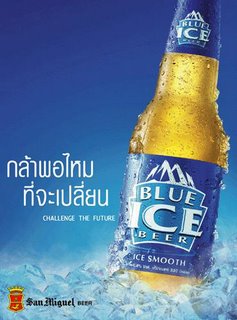Blue Ice Beer
 A new tradition seems to have begun, one that I fully endorse and support. The tradition of giving me the present of beer, whether it is for a gift giving occasion, or after returning from a trip to a far off place. In this case, Angela and Kal returned from there honeymoon in Thailand with a bottle of Blue Ice for me to enjoy.
A new tradition seems to have begun, one that I fully endorse and support. The tradition of giving me the present of beer, whether it is for a gift giving occasion, or after returning from a trip to a far off place. In this case, Angela and Kal returned from there honeymoon in Thailand with a bottle of Blue Ice for me to enjoy.Stats:
Brewery – San Miguel in Pathum Thani, Thailand
Style – European Strong Lager
ABV – 6.4%
Serving Type – 330ml bottle
I must admit that I'm a little nervous about trying this beer. Not only does the name remind me of the blocks of frozen sewage that sometimes leak out of airplanes and freeze, but it also ranks as a '0' on Ratebeer.
The story of the San Miguel Corporation begins way back in the 16th century when the Philippine Islands became a Spanish colony. Spanish monks that came over brought their Knowledge and traditional methods of brewing with them. The monks lived in Manila, specifically a district called “San Miguel”. The first official brewery to be opened in Southeast Asia was “La Fabrica de Cerveza de San Miguel” in 1890 by Don Enrique Maria Barretto de Ycaza. In 1913, La Fabrica became a corporation and began exporting beer to Guam, Hong Kong, and Shanghai. During their first year of production they produced about 47,000 cases of beer. Today, the San Miguel Beer Division (SMBD) has the capacity to produce 325 million cases in 320 ml bottles.
That’s right the company has been growing and diversifying until the original brew is just a small sub-division of the total corporation. In fact San Miguel Corporation is Southeast Asia's largest publicly listed food, beverage, and packaging company. The company has over 100 facilities in the Philippines, Southeast Asia, China, and Australia. The SMBD also brews Miller Genuine Draft, Lowenbrau, and Carlsberg beers under license. Blue Ice beer was introduced to Thailand in the autumn of 2004 (but has been being consumed in the Philippines since 1995), along with another beer called Red Horse, to increase market share in the area. Apparently having 90% of the Philippine market just wasn’t enough.
Glass – “Beer” Pint GlassAroma – I can immediacy pick out the use of European hops. Back in the days when I was a novice beer drinker (who was use to domestic beers and hops) I would clump this aroma in with Skunked beer. Nowadays, however, I know it’s just the hops combined with the brewing process. There is almost no malt aroma, but I can pick out a light corn smell.
Appearance – It pours with a big frothy almost soapy looking white crown that dissipates quickly. There is virtually no lacing. The beer has a light yellow Hue.
Flavor – There is a light sweetness and very little hop flavor. In my first sip I though I got a hint of sourness, but in the next sip it was gone. As with the aroma, I could also pick out some corn flavor. Unfortunately, the antiseptic/medicinal aftertaste killed this beer for me. I just lingered getting worse with each sip until I couldn’t drink it anymore.
Mouthfeel – It has a water mouthfeel with virtually no carbonation. I was really expecting a lot more body with and alcohol content of 6.4%. There was some alcohol evaporation, but it seemed to leave a film in my mouth.
Final Thoughts – At first I was thinking that this beer isn’t so bad, a standard European lager with a light body and not much complexity or flavor, but still good and drinkable. But, then that horrible aftertaste reared its ugly head. The medicinal/band-aid flavor is caused by phenols and is called a Phenolic flavor. There are several reasons for this; most of them have to do with chlorine in the water. However, because it was only in the aftertaste I’m betting that if the beer was fresh there wouldn’t be time for the phenols to activate. While was sadly disappointed by this beer, I hope it don’t discourage anyone else from bringing me a new beer to try. Since I’ll need to taste this beer again when it is fresh, I’ll just have to take a trip to Thailand myselft. One last thing…Congratulations Angela and Kal!!!!

1 Comments:
nice post. thanks.
Post a Comment
<< Home